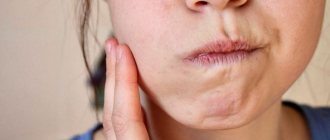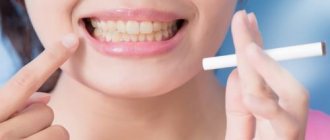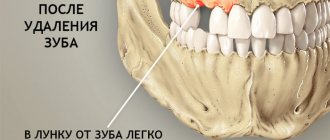01.12.2019
Furacilin is an antimicrobial drug intended for local disinfection of a damaged area of the body. In addition to its main effect, the drug has numerous positive features, thanks to which it is one of the most popular antiseptics in medicine. In dentistry, furatsilin is most often used as a solution for rinsing the mouth after tooth extraction, and is also used at home for toothache.
Composition and release form
The main active component of furatsilin is Nitrofural. This is an antimicrobial substance that has a detrimental effect on most types of microorganisms that form in the oral cavity and cause inflammatory processes. In combination with auxiliary components, some of which enhance the effect of Nitrofural, and others are independent antiseptics, furatsilin in liquid form has the maximum antimicrobial effect. This reduces the intensity of toothache, and after tooth extraction prevents complications and promotes rapid healing of the gums.
Furacilin is available in several forms:
- Pills
- Powder
- Mouth rinse solution
- Alcohol solution.
The most common form is tablets, because they are easy to store, dilute and have no contraindications, unlike an alcohol solution. The product is produced in a blister of 10 tablets of 0.02 g each. A solution for rinsing teeth is prepared at the rate of 1 tablet per 100 ml of water. It is recommended to use warm boiled water above average temperature to dissolve furatsilin as quickly as possible. The prepared solution must be stored in a dark and cool place for no more than 10 days.
Furacilin in powder form is less popular and is practically not used at home due to the complexity of preparing the solution - it is necessary to maintain the proportions exactly. The release form is glass containers with contents weighing 10 g.
Mouth rinse solution is ready for use and is widely used both in dentistry and at home.
An alcohol solution of furatsilin (0.067%) is used in dentistry to cauterize ulcers and wounds, and is also used as a rinse for teeth and canals after extraction. The liquid is not recommended for independent use, as there are contraindications and the possibility of individual intolerance. The use of an alcohol solution should only be started after consultation with a dentist or as directed.
Application of furatsilin
Indications for the use of furatsilin in dentistry are many diseases. The main ones are the following:
- Stomatitis - furatsilin solution is used as a local antiseptic and antimicrobial drug that has an effect on pustular formations;
- Gingivitis is an inflammatory process of the gums located in close proximity to the teeth. Rinsing reduces the severity of pain and prevents the spread of the process;
- Periodontitis is a complicated form of gingivitis, accompanied by bleeding from the gums and extensive inflammation. Rinsing prevents the spread of microorganisms and helps disinfect areas of inflammation;
- Toothache - rinsing teeth with furatsilin helps reduce the intensity of pain and also has an antiseptic effect;
- Tooth extraction - furatsilin solution prevents the development of secondary infections and promotes rapid healing of the gums.
The main advantage of using furatsilin in dentistry is its effect on those microorganisms that are resistant to antibiotics. However, the maximum effect is achieved only with the combined use of the rinsing solution and other medications prescribed by the dentist.
Treatment with Furacilin
In case of facial swelling, it is not recommended to apply any hot compresses, since such a procedure will only aggravate the problem and the inflammatory process will significantly intensify.
It will not be possible to cure gingivitis or flux on your own, as this is fraught with the development of an extensive inflammatory process and the spread of infection to nearby tissues. It is necessary to consult a dentist; thanks to comprehensive treatment procedures, it will be possible to eliminate swelling of the gums and maintain dental health.
When treating flux, anti-inflammatory drugs are usually used, namely Furacilin solution. You can prepare the solution yourself, or purchase a ready-made rinse at the pharmacy.
To prepare an antibacterial solution yourself, you will need to dissolve one tablet of the drug in 200 ml of hot (boiled) water. After all the particles of the tablet have completely dissolved, you can carry out the rinsing procedure.
How to rinse teeth correctly with furatsilin
Mouth rinsing involves several options, depending on the pathology, but for most of them standard techniques are used:
- Mouth rinse
- Rinsing with liquid retention in the mouth for up to 1 minute
- Intensive rinsing of a specific area of the mouth.
A distinctive point is rinsing the mouth with furatsilin after tooth extraction. In this case, the dentist gives clear recommendations that must be followed. The instructions are as follows:
- The first rinse after tooth extraction should be done no earlier than 24 hours later. Otherwise, the liquid may damage the blood clot in the socket, which will lead to complications;
- The solution should be at room temperature;
- The first rinses must be carried out carefully and without harsh actions; it is enough to take the liquid into the oral cavity and hold it on the side of the extracted tooth for no more than a minute, then spit it out;
- The procedure is repeated 3-4 times and no more than 5 times a day.
The course of mouth rinse after tooth extraction is up to 7 days. The active substance Nitrofural prevents the proliferation of pathogenic microorganisms in the area of the extracted tooth, and also has an analgesic and antiseptic effect. Taken together, a set of measures allows you to undergo tooth extraction painlessly and without complications.
Buy Furacilin Avexima effervescent tablets for solution 20 mg No. 10 in pharmacies
Dosage form
Round, flat-cylindrical tablets, from light yellow to yellow with inclusions, with a chamfer on both sides. Tablet surface roughness is acceptable.
Instructions
Locally: externally in the form of a 0.02% freshly prepared aqueous solution: immediately before use, one tablet (20 mg of furatsilin) is dissolved in 100 ml of distilled water at room temperature or in warm boiled water.
Externally: in the form of an aqueous 0.02% solution - irrigate wounds, apply wet bandages.
Locally: blepharitis, conjunctivitis - instillation of an aqueous 0.02% solution into the conjunctival sac. Osteomyelitis after surgery - washing the cavity, followed by applying a wet bandage. Empyema of the paranasal sinuses (including with sinusitis) - washing the cavity, empyema of the pleura - after removing the pus, wash the pleural cavity and inject 20-100 ml of an aqueous 0.02% solution.
To wash the urethra and bladder, use an aqueous 0.02% solution with an exposure of 20 minutes.
For tonsillitis, stomatitis, gingivitis - rinse the mouth and throat with warm 100 ml of an aqueous 0.02% solution 2-3 times a day.
The duration of treatment is as indicated, depending on the nature and location of the affected area. If symptoms persist, it is recommended to consult a doctor.
Externally. Irrigate purulent wounds, bedsores, II-III degree burns, minor skin injuries (including abrasions, scratches, cracks, cuts) and apply wet bandages.
If there is no improvement after treatment, or symptoms worsen, or new symptoms appear, you should consult your doctor.
Use the drug only according to the method of use and in the doses indicated in the instructions. If necessary, please consult your doctor before using the medicine.
Compound
Composition per tablet:
active substance:
nitrofural (furacilin) - 20 mg;
Excipients:
tartaric acid - 375 mg, sodium bicarbonate - 299 mg, sodium carbonate - 325 mg, sodium chloride - 100 mg, macrogol 20000 - 65 mg, medium molecular weight povidone - 16 mg.
Pharmacotherapeutic group
Antimicrobial agent - nitrofuran
Storage temperature
From 2C to 25C
Special conditions
The drug does not affect the ability to drive or exercise
Drug interactions
Not studied.
Pharmacodynamics
Antimicrobial agent, nitrofuran derivative. Bacterial flavoproteins, by reducing the 5-nitro group, form highly reactive amino derivatives that can cause conformational changes in proteins (including ribosomal ones) and other macromolecules, leading to the death of bacteria. Active against gram-positive and gram-negative bacteria, incl. Staphylococcus spp., Streptococcus spp., Escherichia coli, Clostridium perfringens. Resistance develops slowly and does not reach a high degree.
Pharmacokinetics
When applied externally and locally, little is absorbed.
Indications
As part of complex therapy:
Locally: acute tonsillitis (angina), stomatitis, gingivitis, blepharitis, conjunctivitis, osteomyelitis, empyema of the paranasal sinuses and pleura; urinary tract infections - rinsing the cavities.
Externally: purulent wounds, bedsores, II-III degree burns, minor skin damage (including abrasions, scratches, cracks, cuts).
Contraindications
Hypersensitivity to nitrofural, nitrofuran derivatives and/or other components of the drug, bleeding, allergic dermatoses, severe renal dysfunction.
Use during pregnancy and breastfeeding
Use during pregnancy and breastfeeding is possible if the expected benefit to the mother outweighs the potential risk to the fetus or child.
Overdose
No cases of overdose have been reported.
Side effects
Allergic reactions are possible: skin itching, dermatitis.
If any of the side effects indicated in the instructions get worse, or you notice any other side effects not listed in the instructions, tell your doctor.
Impact on the ability to drive vehicles and machinery
The drug does not affect the ability to drive or engage in other potentially hazardous activities that require increased concentration and speed of psychomotor reactions.
Furacilin as a remedy for toothache
The antiseptic solution is not an analgesic in its direct action, but in some cases it can relieve toothache or reduce its intensity. The extent to which the fluid affects pain will depend on the severity of the pain and its cause. When such a situation occurs, the following actions must be taken:
- Prepare a solution of furatsilin by dissolving tablets, or use a ready-made form from a pharmacy;
- Bring liquid to room or warm temperature;
- Rinse the mouth with a primary focus on the diseased side of the tooth;
- Repeat the procedure several times (no more than 4-5 with an interval of fluid retention in the mouth of no more than a minute).
To achieve the best effect, it is recommended to take an analgesic and also make an appointment with a dentist. Rinsing the mouth with furatsilin for toothache can reduce its intensity by cleansing the oral cavity of pathogens, but this does not guarantee getting rid of the main cause of its occurrence.
Furacilin has been used in dentistry for several decades and remains one of the first antiseptics for various pathological processes. Its advantage lies in its effective action on numerous groups of microorganisms, availability of purchase and ease of use.
Category Hygiene, Medicines / preparations Published by Mister stomatolog
Therapeutic effect
If you rinse with Furacilin regularly, then with flux it will be possible to reduce the severity of swelling and eliminate pain, as well as the degree of inflammation.
In case of inflammation of the gums, rinsing will help get rid of severe toothache, which is caused by diseases of the gum tissue.
The drug is quite effective in the presence of wounds on the gums (with stomatitis), it will relieve local inflammation.
If sudden inflammation occurs, an antiseptic solution will relieve severe pain without providing dental care.











